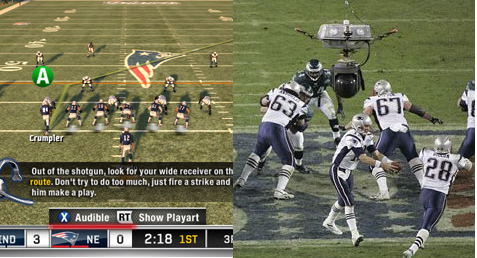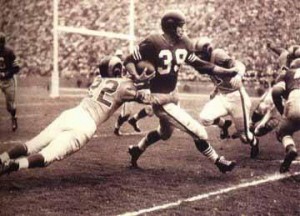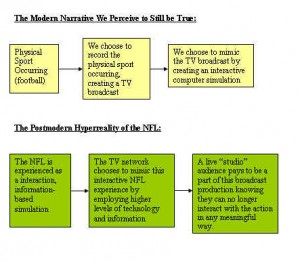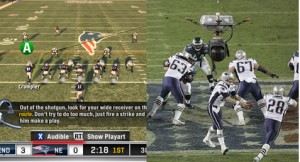
For better or for worst, the National Football League (NFL) currently occupies a very large space in the U.S.’s public consciousness and popular culture. The sheer time and energy spent by both sports media and fandom alike on this sport, alone, justifies its focus as a site of U.S. cultural study. The license to televise the sport generates more than $2 billion a year for the league while its broadcasts are repeatedly high in traditional television ratings, and its official apparel offerings are gobbled up to the point that the league has stepped up efforts to market to women. In simple summation – the NFL is a seemingly infallible sport whose fandom never seems to decrease their collective appetite for more athletic competition. However, there is more going on here beyond the NFL’s self-serving narrative; a more interesting tale that can only be told when we insert Baudrillard’s unique perspective (pictured at the beginning of this post).
Baudrillard believes that as we moved from a modern to a postmodern world the existing boundary between image or simulation and reality is imploded. This new era is one of simulation where computerization and information processing replaces production as the organizing principle of our society.[1] So, just how do Baudrillard’s thoughts pertain to the U.S.’s voracious appetite for the game of professional football? Well, the traditional narrative told by the NFL to fandom goes something like this: “the game of U.S. professional football is very exciting to watch – fans in the stands knew this for years (see image 1). Then, when television came of age, Pete Rozelle saw its potential to translate this inherently dynamic athletic competition to a wider audience. He was correct and for the past 55 years (since the 1958 NFL Championship Game) the audience has continued to both recognize and be awed by the broadcast of this inherently exciting game of football.”
Image 1

However, the truth is actually a much more interesting and complex tale than just this Rozelle/Sabol story. Watching a game of football from the stands can be exciting as you are swept up in the wave of crowd emotions punctuated by a few unexpected or exciting plays. Ever since the Nielsen ratings validated Rozelle’s decision to push his league on to the television screen (and securely for the league regular financial windfalls from television networks), the game is really not played for those who are physically present. Of course, the league enjoys the proceeds from parking, ticket sales (especially VIP boxes), merchandise, and concessions – which for some larger market teams such as the Dallas Cowboys – stadium income can get into the hundreds of millions of dollars. This is no small chunk of change to be sure – but it pales in comparison to the $2 billion per year for television licensing rights. Here’s another way to think about it – for whom does “the action” stop during a game? It stops when the man wearing the bright orange oven mitts waves his hands – he’s telling everybody they need to take a break for television – no matter whether the fan who is physically present and watching the game wants them to or not.
The 1990s saw two very important events occur that helped transform the NFL from a modern sport into a postmodern product: the May 6, 1993 labor agreement and the July 12, 1994 hiring of Sara Levinson as the new president of NFL properties.[2] We’ll deal with the labor agreement a little later, but Ms. Levinson’s (former co-president of MTV) hiring was a deliberate strategy to both consider and revive the NFL as a product that needed to appeal outside its then current primary demographic: aging men who either grew up alongside the maturing NFL or those whose fathers, older brothers or uncles had passed down the ritual of watching the NFL to them. If the NFL wanted to survive long-term it needed to re-invent itself in order to compete against video games, movies, amusement parks, and other sports for the always desired 18-34 year olds’ disposable income. It is these moves during the early 1990s that paved the way for what Baudrillard would call the hyperreal NFL of today – namely EA’s Madden NFL video game franchise.
A little earlier in this essay, I outlined the common narrative given by the NFL regarding its popularity and relationship to television. If we were to continue this narrative, it would say something like “and because television broadcasts of the NFL were so popular, video games now attempt to simulate those broadcasts, and these games have proven to be both very popular and lucrative.” This narrative may have been correct during the 1980s and 1990s, but today it is the exact opposite that is occurring: the simulation itself is what is “real” and in fact television is attempting to mirror or mimic a video game. So, from Baudrillard’s perspective, it is not a physical football game that is real but the Madden video game that is real (see figure 1 below).
Figure 1
If you watch an NFL broadcast on ESPN, NBC, or FOX you are instantly inundated with a plethora of graphic-based information, database-driven statistics, computer-augmented colors, and iris-ed up camera brightness, and increases in ability to score points that add up to being “realer than real.” The perspective you take as viewer follows this logic as the new Skycams mimic the Madden form of the NFL providing camera angles beyond the natural observer’s perspective (see image 2 below). While the Madden franchise’s total overall revenue of $3 billion since its inception[3] doesn’t compare to decades worth of television licensing revenue, it’s still a significant amount of revenue and influence on the coveted youth demographic the NFL can’t ignore. When you add to these observations the television network’s habit of fragmenting and summarizing geography through its selective city amalgamations during their broadcasts (e.g. Philadelphia is ONLY the Art Museum and Geno’s cheese steaks and they seem to be right next to each other) you reach a simulation that has blurred with the real to become hyperreal. Within the actual broadcast itself, major television network game announcers actually ignore details of the game itself so they are not distracted from pre-agreed upon story-points established in production meetings prior to the contest.
Image 2
The result is a television broadcast attempting to replicate EA’s interactive form of football that focuses more on personalities involved in soap-opera type drama that rarely connects to the action occurring on the field. On interpretation is that the actual contest of competitive football is as traditional understood so boring or trite at this point that the hyperreal version is preferred by gamer, television audience, and television producer alike. Football as a concept is today a hyperreal simulation and a television program first whose weekly subject matter is only marginally related to a sport’s “x’s and o’s”. This is not your father’s modern football; welcome to the postmodern NFL.






